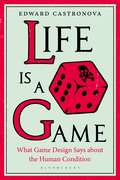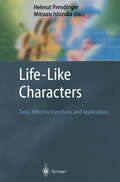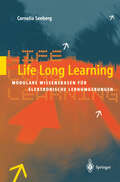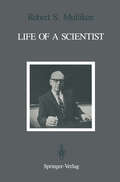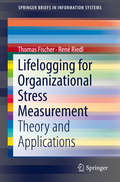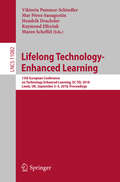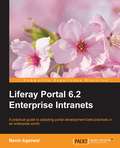- Table View
- List View
Life Is a Game: What Game Design Says about the Human Condition
by Edward CastronovaWhat if life is a game? Are you winning? Have you even decided what 'winning' is?Game design could be defined in many ways, but here the term is used to denote the practice of creating choices. Designing a game, in this sense, involves crafting limits, rewards, incentives, and risks in such a way that the person who interacts with the game – the player – makes choices that have consequences.Edward Castronova urges readers to think about the fundamentals of the human condition and compare them to different games that we all know. In some ways, life is like an idle game: providing unchallenging distractions that fit easily into a person's daily routine. In other ways, life is like the game Minesweeper: You poke in different places to learn about what you don't know, taking care to avoid big explosions. Or, life is like a role-playing game: You adopt a persona and speak your part, always seeking adventure. Bringing together questions relating to diverse fields – such as politics, economics, sociology and philosophy - Castronova persuades readers to broaden the scope of game design to answer questions about life's everyday obstacles. The object of this book is to take seriously the idea that life is a game. The goal is not to make readers wealthier or healthier. Its goal is to go on a journey into the human condition, with game design as a guide.
Life-Like Characters: Tools, Affective Functions, and Applications (Cognitive Technologies)
by Helmut Prendinger Mitsuru IshizukaFor the first time, a comprehensive collection of the latest developments in scripting and representation languages for life-like characters. The text introduces toolkits for authoring animated characters which further supports the practicality and ease of use of this new interface technology. As life-like characters is a vibrant research area, various applications have been designed and implemented. The text covers the most successful and promising applications, ranging from product presentation and student training to knowledge integration and interactive gaming. It also discusses the key challenges in the area and provides design guidelines for employing life-like characters.
Life Long Learning: Modulare Wissensbasen für elektronische Lernumgebungen
by Cornelia SeebergLernen mit elektronischen Dokumenten wird immer wichtiger. Der entscheidende Vorteil des Mediums Computer ist die Möglichkeit, dynamische Dokumente zu erzeugen. Diese Dynamik kann zum einen in den einzelnen Inhalten liegen (Animationen, Simulationen) oder in der Erstellung der Dokumente (adaptive Anpassung an die einzelnen Benutzer/innen). Die Lerndokumente liegen dafür in Modulen, nicht als ein großes Dokument vor. Um diese Vorteile nutzen zu können, müssen die Module beschrieben sein. Das Buch bietet ein Beschreibungsschema, mit dem aus einer Wissensbasis von unzusammenhängenden Modulen ein gut lesbares und auf die Bedürfnisse der einzelnen Leser/innen angepasstes webbasiertes Dokument erstellt werden kann.
Life of a Scientist: An Autobiographical Account of the Development of Molecular Orbital Theory
by Robert S. MullikenRobert S. Mulliken, Nobel Laureate in chemistry, always had the intention to write a book about his field of research: molecular orbital theory. This is his scientific autobiography, edited posthumously by his former student Bernard J. Ransil and complemented with a memoir by Friedrich Hund, his scientific protagonist. Mulliken describes his career and gives an account of the contributions of his friends and colleagues at home and in Europe where he frequently travelled. And last but not least, he gives an accurate history of how the molecular orbital theory originated and how it evolved in an atmosphere of international exchange. The book is written in a particularly lively style, full of reminiscences and scientific facts, interwoven to produce an account of the Life of a Scientist.
Life System Modeling and Intelligent Computing: International Conference on Life System Modeling and Simulation, LSMS 2010, and International Conference on Intelligent Computing for Sustainable Energy and Environment, ICSEE 2010, Wuxi, China, September 17-20, 2010. Proceedings (Lecture Notes in Computer Science #6330)
by Minrui Fei George W. Irwin Kang Li Li Jia Xin SunThe 2010 International Conference on Life System Modeling and Simulation (LSMS 2010) and the 2010 International Conference on Intelligent Computing for Sustainable Energy and Environment (ICSEE 2010) were formed to bring together researchers and practitioners in the fields of life system modeling/simulation and intelligent computing applied to worldwide sustainable energy and environmental applications. A life system is a broad concept, covering both micro and macro components ra- ing from cells, tissues and organs across to organisms and ecological niches. To c- prehend and predict the complex behavior of even a simple life system can be - tremely difficult using conventional approaches. To meet this challenge, a variety of new theories and methodologies have emerged in recent years on life system modeling and simulation. Along with improved understanding of the behavior of biological systems, novel intelligent computing paradigms and techniques have emerged to h- dle complicated real-world problems and applications. In particular, intelligent c- puting approaches have been valuable in the design and development of systems and facilities for achieving sustainable energy and a sustainable environment, the two most challenging issues currently facing humanity. The two LSMS 2010 and ICSEE 2010 conferences served as an important platform for synergizing these two research streams.
Life System Modeling and Intelligent Computing: International Conference on Life System Modeling and Simulation, LSMS 2010, and International Conference on Intelligent Computing for Sustainable Energy and Environment, ICSEE 2010, Wuxi, China, September 17-20, 2010, Proceedings, Part I (Lecture Notes in Computer Science #6328)
by Minrui Fei Li Jia George W. IrwinThe 2010 International Conference on Life System Modeling and Simulation (LSMS 2010) and the 2010 International Conference on Intelligent Computing for Sustainable Energy and Environment (ICSEE 2010) were formed to bring together researchers and practitioners in the fields of life system modeling/simulation and intelligent computing applied to worldwide sustainable energy and environmental applications. A life system is a broad concept, covering both micro and macro components ra- ing from cells, tissues and organs across to organisms and ecological niches. To c- prehend and predict the complex behavior of even a simple life system can be - tremely difficult using conventional approaches. To meet this challenge, a variety of new theories and methodologies have emerged in recent years on life system modeling and simulation. Along with improved understanding of the behavior of biological systems, novel intelligent computing paradigms and techniques have emerged to h- dle complicated real-world problems and applications. In particular, intelligent c- puting approaches have been valuable in the design and development of systems and facilities for achieving sustainable energy and a sustainable environment, the two most challenging issues currently facing humanity. The two LSMS 2010 and ICSEE 2010 conferences served as an important platform for synergizing these two research streams.
Life System Modeling and Intelligent Computing: International Conference on Life System Modeling and Simulation, LSMS 2010, and International Conference on Intelligent Computing for Sustainable Energy and Environment, ICSEE 2010, Wuxi, China, September 17-20, 2010, Proceedings, Part II (Lecture Notes in Computer Science #6329)
by Minrui Fei Li Jia George W. IrwinThe 2010 International Conference on Life System Modeling and Simulation (LSMS 2010) and the 2010 International Conference on Intelligent Computing for Sustainable Energy and Environment (ICSEE 2010) were formed to bring together researchers and practitioners in the fields of life system modeling/simulation and intelligent computing applied to worldwide sustainable energy and environmental applications. A life system is a broad concept, covering both micro and macro components ra- ing from cells, tissues and organs across to organisms and ecological niches. To c- prehend and predict the complex behavior of even a simple life system can be - tremely difficult using conventional approaches. To meet this challenge, a variety of new theories and methodologies have emerged in recent years on life system modeling and simulation. Along with improved understanding of the behavior of biological systems, novel intelligent computing paradigms and techniques have emerged to h- dle complicated real-world problems and applications. In particular, intelligent c- puting approaches have been valuable in the design and development of systems and facilities for achieving sustainable energy and a sustainable environment, the two most challenging issues currently facing humanity. The two LSMS 2010 and ICSEE 2010 conferences served as an important platform for synergizing these two research streams.
Life System Modeling and Intelligent Computing: International Conference on Life System Modeling and Simulation, LSMS 2010, and International Conference on Intelligent Computing for Sustainable Energy and Environment, ICSEE 2010, Wuxi, China, September 17-20, 2010, Proceedings, Part I (Communications in Computer and Information Science #97)
by Kang Li Xin Li Shiwei Ma George W. IrwinThe 2010 International Conference on Life System Modeling and Simulation (LSMS 2010) and the 2010 International Conference on Intelligent Computing for Susta- able Energy and Environment (ICSEE 2010) were formed to bring together resear- ers and practitioners in the fields of life system modeling/simulation and intelligent computing applied to worldwide sustainable energy and environmental applications. A life system is a broad concept, covering both micro and macro components ra- ing from cells, tissues and organs across to organisms and ecological niches. To c- prehend and predict the complex behavior of even a simple life system can be - tremely difficult using conventional approaches. To meet this challenge, a variety of new theories and methodologies have emerged in recent years on life system mod- ing and simulation. Along with improved understanding of the behavior of biological systems, novel intelligent computing paradigms and techniques have emerged to h- dle complicated real-world problems and applications. In particular, intelligent c- puting approaches have been valuable in the design and development of systems and facilities for achieving sustainable energy and a sustainable environment, the two most challenging issues currently facing humanity. The two LSMS 2010 and ICSEE 2010 conferences served as an important platform for synergizing these two research streams.
Life System Modeling and Intelligent Computing: International Conference on Life System Modeling and Simulation, LSMS 2010, and International Conference on Intelligent Computing for Sustainable Energy and Environment, ICSEE 2010, Wuxi, China, September 17-20, 2010, Proceedings, Part II (Communications in Computer and Information Science #98)
by Kang Li Xin Li Shiwei Ma George W. IrwinThe 2010 International Conference on Life System Modeling and Simulation (LSMS 2010) and the 2010 International Conference on Intelligent Computing for Susta- able Energy and Environment (ICSEE 2010) were formed to bring together resear- ers and practitioners in the fields of life system modeling/simulation and intelligent computing applied to worldwide sustainable energy and environmental applications. A life system is a broad concept, covering both micro and macro components ra- ing from cells, tissues and organs across to organisms and ecological niches. To c- prehend and predict the complex behavior of even a simple life system can be - tremely difficult using conventional approaches. To meet this challenge, a variety of new theories and methodologies have emerged in recent years on life system mod- ing and simulation. Along with improved understanding of the behavior of biological systems, novel intelligent computing paradigms and techniques have emerged to h- dle complicated real-world problems and applications. In particular, intelligent c- puting approaches have been valuable in the design and development of systems and facilities for achieving sustainable energy and a sustainable environment, the two most challenging issues currently facing humanity. The two LSMS 2010 and ICSEE 2010 conferences served as an important platform for synergizing these two research streams.
Life System Modeling and Simulation: International Conference on Life System Modeling, and Simulation, LSMS 2007, Shanghai, China, September 14-17, 2007. Proceedings (Lecture Notes in Computer Science #4689)
by Minrui Fei George W. Irwin Shiwei MaThis book is part of a two-volume work that constitutes the refereed proceedings of the International Conference on Life System Modeling and Simulation, LSMS 2007, held in Shanghai, China, September 2007. Coverage includes modeling and simulation of societies and collective behavior, computational methods and intelligence in biomechanical systems, tissue engineering and clinical bioengineering, computational intelligence in bioinformatics and biometrics, and brain stimulation.
Life System Modeling and Simulation: International Conference on Life System Modeling and Simulation, LSMS 2014, and International Conference on Intelligent Computing for Sustainable Energy and Environment, ICSEE 2014, Shanghai, China, September 2014, Proceedings, Part I (Communications in Computer and Information Science #461)
by Shiwei Ma Li Jia Xin Li Ling Wang Huiyu Zhou Xin SunThis book constitutes the first part of the refereed proceedings of the International Conference on Life System Modeling and Simulation, LSMS 2014, and of the International Conference on Intelligent Computing for Sustainable Energy and Environment, ICSEE 2014, held in Shanghai, China, in September 2014. The 159 revised full papers presented in the three volumes of CCIS 461-463 were carefully reviewed and selected from 572 submissions. The papers of this volume are organized in topical sections on biomedical signal processing, imaging, and visualization; computational methods and intelligence in modeling genetic and chemical networks and regulation; computational methods and intelligence in organism modeling; computational methods and intelligence in modeling and design of synthetic biological systems; computational methods and intelligence in biomechanical systems, tissue engineering and clinical bioengineering; intelligent medical apparatus and clinical applications; modeling and simulation of societies and collective behaviour; innovative education in systems modeling and simulation; data analysis and data mining of biosignals; feature selection; robust optimization and data analysis.
Lifehacker: The Guide to Working Smarter, Faster, and Better
by Adam Pash Gina TrapaniA new edition, packed with even more clever tricks and methods that make everyday life easier Lifehackers redefine personal productivity with creative and clever methods for making life easier and more enjoyable. This new edition of a perennial bestseller boasts new and exciting tips, tricks, and methods that strike a perfect balance between current technology and common sense solutions for getting things done. Exploring the many ways technology has changed since the previous edition, this new edition has been updated to reflect the latest and greatest in technological and personal productivity. The new "hacks" run the gamut of working with the latest Windows and Mac operating systems for both Windows and Apple, getting more done with smartphones and their operating systems, and dealing with the evolution of the web. Even the most tried-and-true hacks have been updated to reflect the contemporary tech world and the tools it provides us. Technology is supposed to make our lives easier by helping us work more efficiently. Lifehacker: The Guide to Working Smarter, Faster, and Better, Third Edition is your guide to making that happen!
Lifehacker: The Guide to Working Smarter, Faster, and Better
by Adam Pash Gina TrapaniA new edition, packed with even more clever tricks and methods that make everyday life easier Lifehackers redefine personal productivity with creative and clever methods for making life easier and more enjoyable. This new edition of a perennial bestseller boasts new and exciting tips, tricks, and methods that strike a perfect balance between current technology and common sense solutions for getting things done. Exploring the many ways technology has changed since the previous edition, this new edition has been updated to reflect the latest and greatest in technological and personal productivity. The new "hacks" run the gamut of working with the latest Windows and Mac operating systems for both Windows and Apple, getting more done with smartphones and their operating systems, and dealing with the evolution of the web. Even the most tried-and-true hacks have been updated to reflect the contemporary tech world and the tools it provides us. Technology is supposed to make our lives easier by helping us work more efficiently. Lifehacker: The Guide to Working Smarter, Faster, and Better, Third Edition is your guide to making that happen!
Lifelogging for Organizational Stress Measurement: Theory and Applications (SpringerBriefs in Information Systems)
by Thomas Fischer René RiedlIn recent decades, organizational stress researchers have repeatedly called for more longitudinal studies. This book argues that tools and devices that have been developed for the private or organizational domains could be helpful when it comes to studying longitudinal phenomena, as they offer unobtrusive measurement and are frequently employed by many individuals in daily life. In particular, the book examines lifelogging, a research field that addresses the computer-based collection of individual experiences. Further, it highlights areas in organizational stress research that benefit from insights in the lifelogging literature and provides a summary of tools that can be used for stress measurement. It also offers an overview of the latest research and current developments on lifelogging and organizational stress for researchers interested in self-measurement of stress-related effects and for organizational stress researchers.
Lifelong and Continual Learning Dialogue Systems (Synthesis Lectures on Human Language Technologies)
by Sahisnu Mazumder Bing LiuThis book introduces the new paradigm of lifelong and continual learning dialogue systems to endow dialogue systems with the ability to learn continually by themselves through their own self-initiated interactions with their users and the working environments. The authors present the latest developments and techniques for building such continual learning dialogue systems. The book explains how these developments allow systems to continuously learn new language expressions, lexical and factual knowledge, and conversational skills through interactions and dialogues. Additionally, the book covers techniques to acquire new training examples for learning new tasks during the conversation. The book also reviews existing work on lifelong learning and discusses areas for future research.
Lifelong Learning in the Digital Age: Sustainable for all in a changing world (IFIP Advances in Information and Communication Technology #137)
by Tom J. Van Weert Mike KendallLifelong Machine Learning (Synthesis Lectures on Artificial Intelligence and Machine Learning)
by Zhiyuan Chaudhri Bing LiuLifelong Machine Learning (or Lifelong Learning) is an advanced machine learning paradigm that learns continuously, accumulates the knowledge learned in previous tasks, and uses it to help future learning. In the process, the learner becomes more and more knowledgeable and effective at learning. This learning ability is one of the hallmarks of human intelligence. However, the current dominant machine learning paradigm learns in isolation: given a training dataset, it runs a machine learning algorithm on the dataset to produce a model. It makes no attempt to retain the learned knowledge and use it in future learning. Although this isolated learning paradigm has been very successful, it requires a large number of training examples, and is only suitable for well-defined and narrow tasks. In comparison, we humans can learn effectively with a few examples because we have accumulated so much knowledge in the past which enables us to learn with little data or effort. Lifelong learning aims to achieve this capability. As statistical machine learning matures, it is time to make a major effort to break the isolated learning tradition and to study lifelong learning to bring machine learning to new heights. Applications such as intelligent assistants, chatbots, and physical robots that interact with humans and systems in real-life environments are also calling for such lifelong learning capabilities. Without the ability to accumulate the learned knowledge and use it to learn more knowledge incrementally, a system will probably never be truly intelligent. This book serves as an introductory text and survey to lifelong learning.
Lifelong Machine Learning, Second Edition (Synthesis Lectures on Artificial Intelligence and Machine Learning)
by Zhiyuan Sun Bing Leno da SilvaLifelong Machine Learning, Second Edition is an introduction to an advanced machine learning paradigm that continuously learns by accumulating past knowledge that it then uses in future learning and problem solving. In contrast, the current dominant machine learning paradigm learns in isolation: given a training dataset, it runs a machine learning algorithm on the dataset to produce a model that is then used in its intended application. It makes no attempt to retain the learned knowledge and use it in subsequent learning. Unlike this isolated system, humans learn effectively with only a few examples precisely because our learning is very knowledge-driven: the knowledge learned in the past helps us learn new things with little data or effort. Lifelong learning aims to emulate this capability, because without it, an AI system cannot be considered truly intelligent. Research in lifelong learning has developed significantly in the relatively short time since the first edition of this book was published. The purpose of this second edition is to expand the definition of lifelong learning, update the content of several chapters, and add a new chapter about continual learning in deep neural networks—which has been actively researched over the past two or three years. A few chapters have also been reorganized to make each of them more coherent for the reader. Moreover, the authors want to propose a unified framework for the research area. Currently, there are several research topics in machine learning that are closely related to lifelong learning—most notably, multi-task learning, transfer learning, and meta-learning—because they also employ the idea of knowledge sharing and transfer. This book brings all these topics under one roof and discusses their similarities and differences. Its goal is to introduce this emerging machine learning paradigm and present a comprehensive survey and review of the important research results and latest ideas in the area. This book is thus suitable for students, researchers, and practitioners who are interested in machine learning, data mining, natural language processing, or pattern recognition. Lecturers can readily use the book for courses in any of these related fields.
Lifelong Technology-Enhanced Learning: 13th European Conference on Technology Enhanced Learning, EC-TEL 2018, Leeds, UK, September 3-5, 2018, Proceedings (Lecture Notes in Computer Science #11082)
by Viktoria Pammer-Schindler Mar Pérez-Sanagustín Hendrik Drachsler Raymond Elferink Maren ScheffelThis book constitutes the proceedings of the 13th European Conference on Technology Enhanced Learning, EC-TEL 2018, held in Leeds, UK, in September 2018.The 42 full and short papers, 7 demo papers, and 23 poster papers presented in this volume were carefully reviewed and selected from 142 submissions. This year, the European Conference on Technology-Enhanced Learning (EC-TEL) will engage researchers, practitioners, educational developers, entrepreneurs and policy makers in a joint discussion on how to put science, technology and practice at the service of learning to embrace these challenges on the topic: Lifelong technology enhanced learning: Dealing with the complexity of 21st century challenges. Chapter "" is available open access under a Creative Commons Attribution 4.0 International License via link.springer.com.
Liferay 6.x Portal Enterprise Intranets Cookbook
by Piotr Filipowicz Katarzyna ZiolkowskaIf you are a Java developer or administrator with a technical background and want to install and configure Liferay Portal as an enterprise intranet, this is the book for you. In short, reusable recipes help you realize business goals as working features in Liferay. This book will also give you useful hints on how to easily improve the default functionality of the system and its performance.
Liferay Beginner's Guide
by Robert Chen Sandeep Nair Samir BhattPart of Packt's Beginner's Guide series, each chapter follows the creation of a fictional neighbourhood site to demonstrate an aspect of Liferay portal with practical examples, screenshots, and step-by-step instructions. All you need in order to benefit from the Liferay Beginner's Guide is programming experience. No prior knowledge of Liferay is required, although experienced Liferay portal programmers who need to get up to speed with its latest features will also find this book useful.
Liferay Portal 5.2 Systems Development
by Jonas X. YuanThis book focuses on teaching by example. Every chapter provides an overview, and then dives right into hands-on examples so you can see and play with the solution in your own environment. All code samples run on both the latest Enterprise and Community releases. This book will be most useful to professional Java developers who want to build custom web sites, portals, and highly customized intranet applica This book is for Java developers, and you will get most from the book if you already work with Java but you need not have prior experience on Liferay portal. Although Liferay portal makes heavy use of open source frameworks such as Spring, Hibernate, Struts, and Lucene, no prior experience using these is assumed.
Liferay Portal 6.2 Enterprise Intranets
by Navin AgarwalA practical guide to adopting portal development best practices in an Enterprise world About This Book • Discover the new features and updates in Liferay including the concept of CMS, and collaboration applications with relevant examples and screenshots • Set up the navigation structure for the Enterprise intranet • Full of illustrations, diagrams, clear step-by-step instructions, and practical examples to show you the integration between different applications such as LDAP, SSO, and Liferay Social Office Who This Book Is For This book is for anyone who is interested in the Liferay Intranet Portal. This book is for both beginners and more experienced portal developers who need to create an enterprise intranet portal for their business. It will be handy for IT professionals who know the basics of how the portal technology works and need to integrate different open source technologies. What You Will Learn • Be introduced to the all new features of Liferay 6.2 • Understand the different controls/actions to make the portal work for an Enterprise • Manage users, organizations, sites, user groups, and roles and also set up portal permissions • Set up a forum and get detailed descriptions of categorization, tagging, and Asset Publisher • Enable Wiki to share knowledge among users and create new dynamic data list and poll portlets • Handle federated search and OpenSearch and deploy search-based portlets • Implement web content management with a different approach in the portal • Employ community tools such as invitations, bookmarks, page comments, and page ratings • Manage Liferay's document and media portlet In Detail To develop an intranet portal for an Enterprise, Liferay is the only open-source portal development platform that has a high scale graph for the developer to extend any component. It provides high end integration with other applications. By using this book, both beginners and more experienced users will be able to create an intranet portal easily. This book will be your pocket reference to Liferay. It will explain to you the new features of Liferay, including Liferay Sync and the Recycle Bin. It will help you to integrate with other key applications such as LDAP, SSO, and Alfresco 4.x and above. You will be introduced to documents, web content, and image management. You will move onto Liferay Sync's new tool to synchronize documents and media files to the local system. You'll discover the Market Place, the newest feature of Liferay. Liferay Social Office and its integrations are also thoroughly explained. This book is packed with practical examples that will help you to develop an intranet portal quickly and easily. Style and approach Clear step-by-step instructions to develop an intranet portal for Enterprise. It describes new features and updates in Liferay with clear explanations, and is complete with images, tips, and tricks.
Liferay Portal Enterprise Intranets: A Practical Guide To Building A Complete Corporate Intranet With Liferay
by Jonas X. YuanThis book is a well-illustrated and practical guide to implementing and understanding Scalix. It includes exhaustive references to the relevant online documents and RFCs. This book is written for Linux administrators who wish to set up an email server for businesses or who wish to switch to Scalix from another email server. Scalix can be used very easily by beginners; however, advanced strategies and administrative tasks are difficult to learn and this book will help you master them all.
Liferay Portal Performance Best Practices
by Samir BhattA step-by-step tutorial on implementing Liferay- based portals to learn performance best practices.The book is good for Liferay portal developers and architects who want to learn performance best practices for implementing Liferay- based solutions. It is assumed that you have a working knowledge of the Liferay portal.
